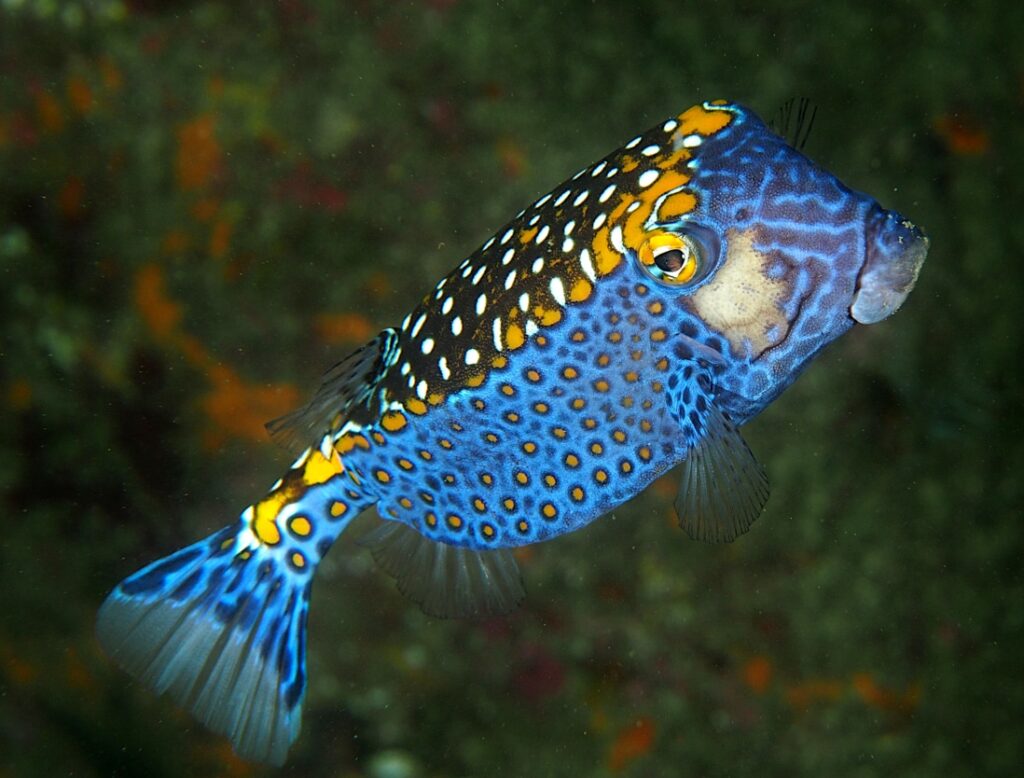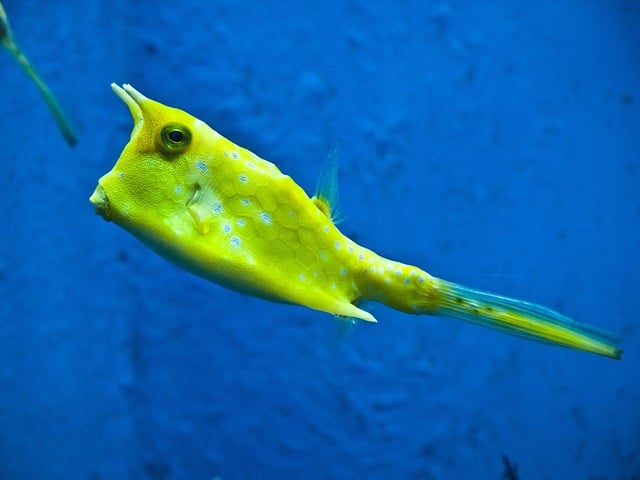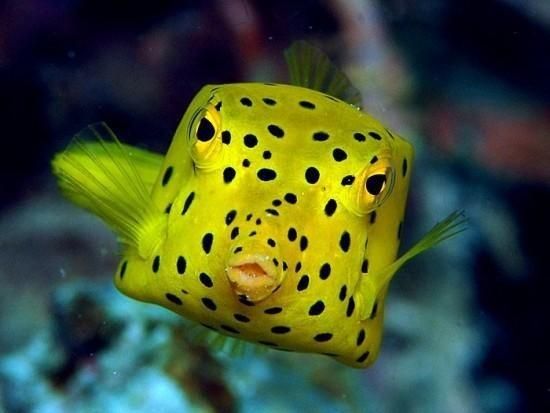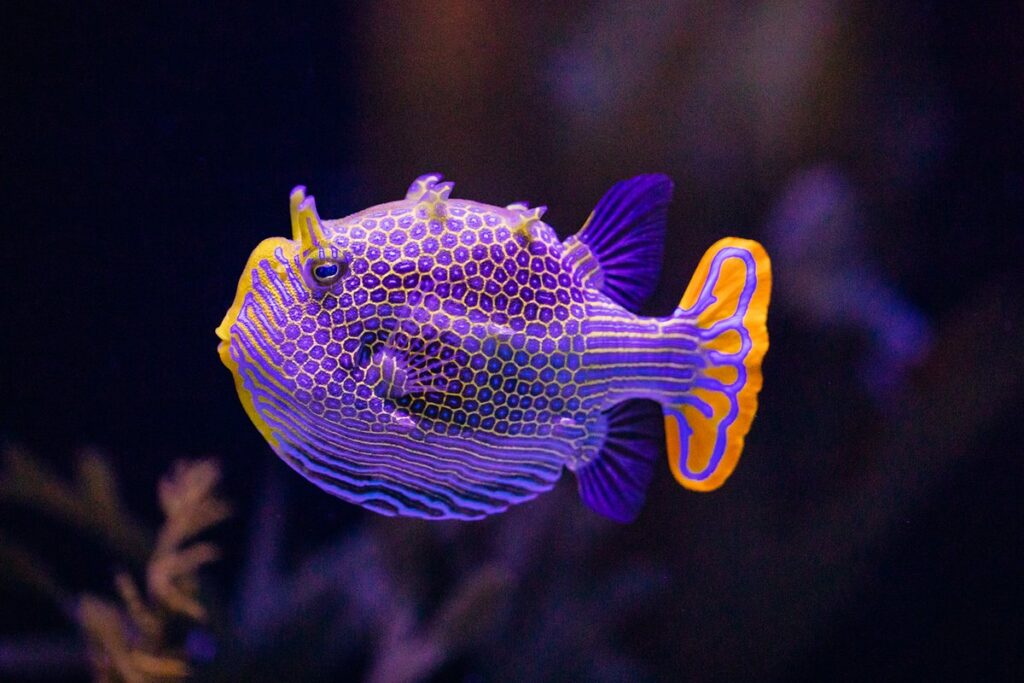The Boxfish is a cute little fish with a box-like body, the yellow boxfish is the cutest of the boxfishes. The yellow boxfish (Ostracion cubicum) is a species of boxfish. It is found in reefs throughout the Pacific Ocean and the Indian Ocean as well as the southeastern Atlantic Ocean.
The Boxfish belongs to the family Ostraciidae and the class Actinopterygii. There are 23 species of fish in the Ostraciidae family. They are closely related to pufferfishes and filefishes. Fishes in this family are known as cofferfishes, cowfishes, and trunkfishes.

The scientific name of the boxfish is Ostracion cubicus. The Latin word Ostracion means shell which refers to the carapace or shell structure of this fish. Cubicus means cube-like.
They come in many colors making them incredibly desirable for pet owners. Many people around the world keep them in their aquariums. They’re sometimes sold as colorful additions to an aquarium.
But they are not easy to maintain pets. They are saltwater fish that need a water temperature between 72 and 78-degrees Fahrenheit. In addition, they require a water pH level between 8.1 and 8.4.
There are many beautiful boxfishes in the ocean some of them are Yellow boxfish, Polka-dot Box Fish, Blue-Spotted Boxfish, Spotted boxfish, Smooth trunkfish, and Roundbelly cowfish. They are one of the most desirable and equally frustrating fishes to keep.
Where is the boxfish found?
These fish are found in the Pacific, Indian, and southeastern Atlantic Oceans. They are also found off the western and eastern coasts of Australia.
In Australia, these fish are found from the central coast of Western Australia around the tropical north and down the east coast to the south of Sydney, New South Wales.
Boxfish also live off the southeastern coast of the United States. The buffalo trunkfish is mainly found in Florida waters and as far north as Cape Cod.
They prefer warm shallow waters and are often found around coral reefs at depths of 1 m to 40 m.

Boxfish Appearance
The appearance of these fish changes as it grow older. Let’s take the example of the yellow boxfish. As a juvenile, Yellow Boxfish is shaped like a box with large black spots on a bright yellow body. When reaching adult size the yellow turns into more of a brownish color/greenish color and their spots decrease.
The body of males and females also defer from one another. The males are a little larger with a more purple/brown color and lighter colored dots. Mature males are often more colorful than females.
Their boxy shape is due to the shell structure beneath their scales. The shape of the boxfish controls water flow around the body to influence stability and maneuverability. This odd shape makes them very slow swimmers. They swim in a rowing manner.
The boxfish is a slow-moving fish that is hardly designed for fast swimming. However, if they are in a hurry, they can make a rapid dash.
These fish grow to a size ranging from 3 to 16 inches. The longest is 20 inches long. Some of these fishes also have spines or angular ridges on their body. Cowfish are spiky versions of boxfish.
They get their name from the rectangular shell of bony armor on the front two-thirds of their bodies. The eyes, mouth, and fins poke through holes in the covering. Different species of boxfish resemble triangles, squares, or pentagons.

Are boxfish poisonous?
Yes, they are poisonous but they can’t kill humans like their relative pufferfish. Pufferfish and boxfish are relatives in terms of appearance and habits. But there’s a huge difference in both fish, pufferfish contain a poison that can kill humans within hours or minutes.
On the other hand when boxfish get captured or stressed they secrete a toxic chemical through their skin which can act as a defense mechanism. Boxfish have this intriguing method of defense against predators, such as sharks and other big fishes.
They secrete deadly toxins, called ostracitoxin, also known as pahutoxin, a type of chemical compound known as a “surfactant.” It is the main toxin in their mucus layer.
This toxin is poisonous to other fishes and can even kill the boxfish itself if it is confined in an aquarium. Although it is not a powerful and deadly poison like the pufferfish.
But this doesn’t stop humans from eating this fish. However, take note that a boxfish must be cooked by an expert correctly to ensure its poison is gone.

Diet
They have an omnivorous diet. Boxfish feed on a variety of bottom-dweller organisms. They feed on crustaceans, worms, and sponges off rocks and coral with their tiny tube-like delicate mouth. Boxfish diet also includes marine algae and small fish including krill.
Reproduction and Lifespan
Their reproduction happens in summer or when the waters start to warm. They form groups including one male and two to four females. The males spend their time with females and show their interest in females by shining bright colors and dancing.
A female boxfish can lay eggs every day for a month. The females lay eggs that float near the surface. The male boxfish releases sperm to fertilize the eggs.
They can live up to 4-8 years depending on the species.

Conservation status
These fish belongs to the category of Not Evaluated in their conservation status. Also, their population estimated is unknown.

